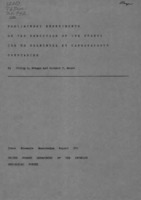An aqueous solution of uranyl sulfate containing a suspension of subbituminous coal has been heated at 210 C for three days. Examination of the coal at the end of the experiment showed it to contain 31.8 percent uranium recognizable as uraninite by a sharp, strong X-ray diffraction pattern. A similar experiment with degraded spruce wood also led to the formation of uraninite but in lesser quantity and with broader lines in the X-ray diffraction pattern. The ability of coal or wood to reduce the uranyl ion is a critical factor in the correlation of studies of uraniferous coals containing the uranyl ion with studies of uraninite-bearing coalified wood from the Colorado Plateau. Although these results are based an preliminary experiments, they are extremely important geochemically and warrant the development of the series of controlled studies that are proposed.


